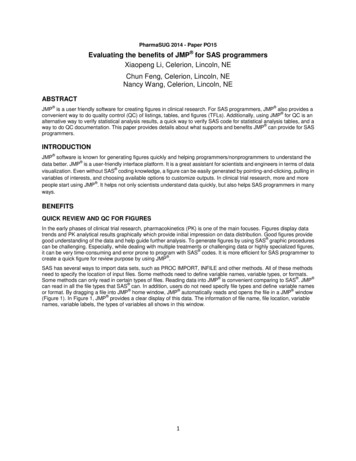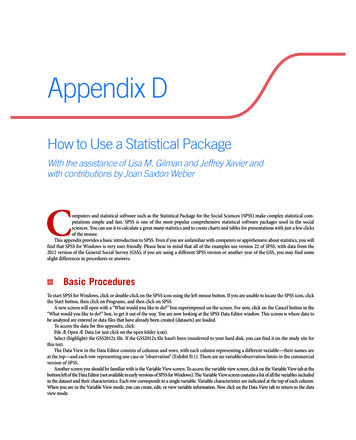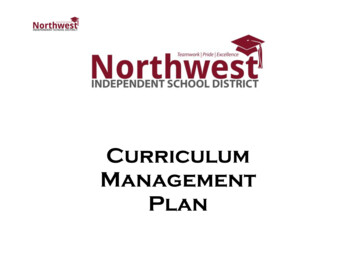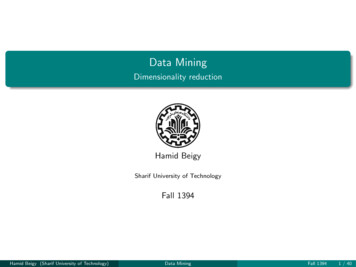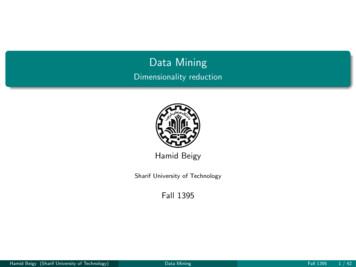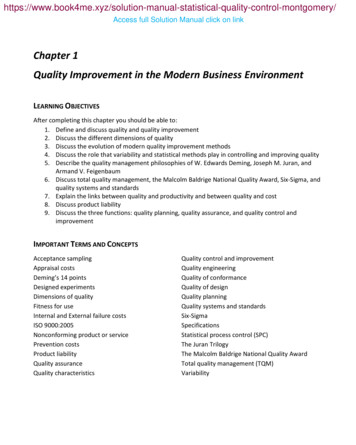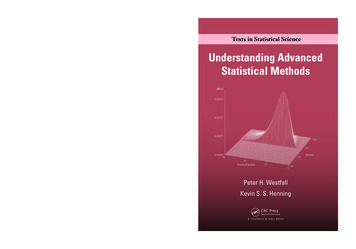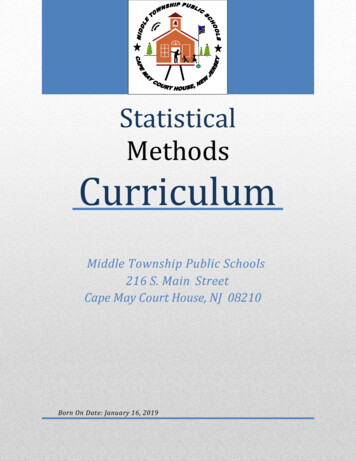
Transcription
StatisticalMethodsCurriculumMiddle Township Public Schools216 S. Main StreetCape May Court House, NJ 08210Born On Date: January 16, 20196 Page1
Table of ContentsAcknowledgements .1Introduction . .2Course Description .3-4Pacing Guide .5-6Unit Plans .7-46Unit 1-Introduction to Statistics . 7-10Unit 2 – Descriptive Statistics . 11-14Unit 3 – Probability Introduction . 15-18Unit 4- Discrete Probability Distributions . 19 -22Unit 5 – Normal Probability Distributions . 23-26Unit 6 – Confidence Intervals .27 - 30Unit 7 – Hypothesis Testing with One Sample . 31- 34Unit 8 – Hypothesis Testing with Two Samples .35 - 38Unit 9 – Correlation and Regression.39 - 42Unit 10 – Chi – Square . 43-46Accommodations/Modifications . 47Resources .48AcknowledgementsDr. David SalvoDr. Toni LehmanGeorge WestSuperintendentDirector of Curriculum and InstructionPrincipal, Middle Township High School2
Statistical Methods Curriculum Work CommitteeKelsey GrahamStatistical Methods Course OverviewStatistical Methods is offered to any student who has successfully completed a second-year course in algebra and who possessessufficient mathematical maturity and quantitative reasoning ability. Students with the appropriate mathematical background areencouraged to take both Statistical Methods and Honors Calculus in High School. There are six themes in the Statistical Methodscourse: exploring data, sampling and experimentation, anticipating patterns, and statistical inference. Upon completion of thiscourse, students should possess the skills necessary to be successful in subsequent mathematics courses.Student Learning Outcomes1. STUDENT LEARNING OUTCOME: Student will build frequency distributions and present statistical results graphically.2. STUDENT LEARNING OUTCOME: Student will describe data with descriptive statistics.3. STUDENT LEARNING OUTCOME: Student will apply counting techniques to probability and discrete probability distributions.4. STUDENT LEARNINGOUTCOME: Student will construct and employ confidence intervals.5. STUDENT LEARNINGOUTCOME: Student will apply the normal distribution, confidence intervals, sample size, hypothesis testing, analysisof variance, correlation, and regression to obtain statistical results with which they will draw conclusions.6. STUDENT LEARNING OUTCOME: Student will use technology to help solve problems, experiment, analyze results, interpret results, andverify conclusions.3
New Jersey State Department of EducationCore Curriculum Content StandardsA note about Mathematics Standards and Cumulative Progress Indicators.A complete copy of the Core Curriculum Content Standards for Mathematics may also be found at:NJDOE Mathematics Model Curriculum Grades th/NJDOE Mathematics Curriculum K-12 /standards.pdfCommon Core State Standards Initiative -- Mathematicshttp://www.corestandards.org/Math/4
Statistical MethodsScope and SequenceQuarter IUnit 1 Introduction to StatisticsI.II.III.Data classificationVariable and Data TypesData Collection and Experimental DesignUnit 2 Descriptive Statistics:I.II.III.IV.V.Frequency Distributions and their GraphsHistograms, Ogive, Stem Plot, Dot Plot, Scatter PlotMeasures of Central TendencyMeasures of VariationMeasures of PositionUnit 3 Probability Introduction:I.II.III.Basic Concepts of Probability and CountingThe Multiplication RuleThe Addition RuleQuarter IIUnit 4 Discrete Probability Distributions:I.II.III.Probability DistributionsBinomial DistributionsMean, Variance, Standard Distribution, ExpectationUnit 5 Normal Probability Distributions:I.II.III.IV.Introduction to Normal DistributionsNormal Distributions: ProbabilitiesNormal Distributions: Finding ValuesCentral Limit Theorem5
Quarter IIIUnit 6 Confidence Intervals:I.II.III.Confidence Intervals for the Mean (σ known)Confidence Intervals for the Mean (σ unknown)Confidence Intervals for Variance and Standard DeviationUnit 7 Hypothesis testing with One Sample:I.II.III.IV.V.Introduction to Hypothesis TestingHypothesis Testing for a Mean (σ known)Hypothesis Testing for a Mean (σ unknown)Hypothesis Testing for a ProportionHypothesis Testing for Variance and Standard DeviationUnit 8 Hypothesis Testing with Two Samples:I.II.Testing the Difference Between Two MeansTesting the Difference between Two VariancesQuarter IVUnit 9 Correlation and Regression:I.II.CorrelationRegressionUnit 10 Chi-Square:I.II.Chi-Square TestAnalysis of Variance6
Suggesteddays ofInstruction15 daysSubject/Grade Level: 11/12Statistical MethodsUnit 1: Introduction to StatisticsTopic: Data Collection and ClassificationOverarching Goals:(1) Communicate mathematical ideas in clear, concise, organized language that varies in content, formatand form for different audiences and purposes.(2) Comprehend, understand, analyze, evaluate, critique, solve, and respond to a variety of real-life,meaningful problems.(3) Investigate, research, and synthesize various information from a variety of media sources.Goal 1:The student will be able to use basis of language of statistics while collecting data andclassifying the various data types.Student Learning Outcome: Student will describe data with descriptive statistics.Objectives / Cluster Concepts /Cumulative ProgressIndicators (CPI's) The studentwill be able to:Essential Question(s): What provocative questions will foster inquiry, understanding, and transfer oflearning?7
1.1.Define statistics and itsbranches (i.e. descriptiveand inferential)S-IC A-11.2.1.3.1.5.Distinguish data sets S-IC A-2Types of data, quantitativeand qualitative S-ID B-5Levels of measurement,nominal, ordinal, interval,ratio S-ID B-5Design of a statistical study1.6.1.7.1.8.1.9.Data Collection S-IC A-1Observational Study S-IC B-3Experimental Design S-IC B-3Sampling Techniques1.4.Essential Questions: How do you collect and classify data? How do you distinguish between descriptive and inferential statistics? How do you distinguish between quantitative and qualitative data? What are considerations when collecting data, including technique and ethical concerns? How do you design a statistical study? How do you design a sample with and without bias using various sampling techniques?S-IC B-3S-IC B-4In this unit plan, the following 21st Century themes and skills are addressed:Check all that apply.21st Century ThemesXXIndicate whether these skills are E-Encouraged, T-Taught, or A-Assessed in this unit by marking E,T, A on the line before the appropriate skill.21st Century SkillsGlobal AwarenessE,T,ACritical Thinking & Problem SolvingEnvironmental LiteracyE,T,ACreativity and InnovationHealth LiteracyE,T,ACollaboration, Teamwork and LeadershipCivic LiteracyE,T,ACross-Cultural and Interpersonal CommunicationFinancial, Economic, Business andCommunication and Media Fluency8
Entrepreneurial LiteracyAccountability, Productivity and EthicsIn this unit plan, the following Career Ready Practices are addressed:Indicate whether these skills are E-Encouraged, T-Taught, or A-Assessed in this unit by marking E, T, A on the line before the appropriate skill.CRP1. Act as a responsible and contributing citizen and employeeE,T,ACRP2. Apply appropriate academic and technical skillsCRP3. Attend to personal health and financial well-beingE,T,AE,TCRP4. Communicate clearly and effectively with reasonCRP5. Consider the environmental, social and economic impacts of decisionsE,T,ACRP6. Demonstrate creativity and innovationE,T,ACRP7. Employ valid and reliable research strategiesE,T,ACRP8. Utilize critical thinking to make sense of problems and persevere in solving them9
CRP9. Model integrity, ethical leadership and effective managementECRP10. Plan education and career paths aligned to personal goalsE, T, ACRP11. Use technology to enhance productivityE,TCRP12. Work productively in teams while using cultural global competenceAssessment Evidence:Formative:(Through what authentic performance tasks willstudents demonstrate the desired understandings? By what criteriawill performances of understanding be judged?)NOTE: The assessment models provided in this document are suggestionsfor the teacher. If the teacher chooses to develop his/her own model, itmust be of equal or better quality and at the same or higher cognitivelevels (as noted in parentheses).Depending upon the needs of the class, the assessment questions may beanswered in the form of essays, quizzes, mobiles, PowerPoint, oralreports, booklets, or other formats of measurement used by the teacher.Summative Assessment Measures: (Through what other evidence (E.g.quizzes, tests, academic prompts, observations, homework, journals, etc.) willstudents demonstrate achievement of the desired results? How will studentsreflect upon and self- assess their learning?) ***Attach all BenchmarksLesson QuizzesUnit TestHomework – per lessonACCC Math 220 – Lab #2Case Study Rating Television ShowsReal Statistics – Real Decisions project10
Suggesteddays ofInstruction15 daysSubject/Grade Level: 11/12Statistical MethodsUnit 2 Descriptive StatisticsTopic: The use of descriptive statistics as a toolOverarching Goals:(1) Communicate mathematical ideas in clear, concise, organized language that varies in content, formatand form for different audiences and purposes.(2) Comprehend, understand, analyze, evaluate, critique, solve, and respond to a variety of real-life,meaningful problems.(3) Investigate, research, and synthesize various information from a variety of media sources.Goal 2:The student will be able to organization and description of data sets to make data easier tounderstand by describing trends, averages, and variationsStudent Learning Outcome: Student will build frequency distributions and present statistical resultsgraphically; Student will describe data with descriptive statisticsObjectives / ClusterConcepts /Cumulative ProgressIndicators (CPI's)The student will be ableto:Essential Questions, Enduring Understandings, Sample Conceptual Understandings11
2.1.2.2.FrequencyDistribution S-ID A-2Graphs of FrequencyDistributions (i.e.histogram, frequencypolygon, ogive)S-ID A-12.3a Electronicconstruction of graphsusing frequencydistributions S-ID A-12.3. Graphing QuantitativeData Sets (i.e.stemplot, dot plot)S-ID A-12.4.Graphing QualitativeData Sets (i.e. piechart, Pareto)Essential Questions: How do you organize and describe data sets? How do you graph and interpret quantitative data sets using histograms and ogives? How do you graph and interpret quantitative data sets using stem and dot plots? How do you graph and interpret qualitative data sets using pie charts and Pareto charts? How do you graph and interpret paired data sets using scatter plots and time series charts? How do you describe data with measures of central tendency, variation, and/or position? How do you interpret numerical descriptions of data sets? How do you find variance and standard deviation od a population and sample? How do you use coefficient of variation to compare variation in different data sets? How do you use quartiles to describe data sets? How do you interpret other fractals such as percentiles and how to find percentiles? How to find and interpret the standard score?S-ID B-52.4a Graphing Paired DataSets (i.e. scatter plot,time series chart) S-IDB-62.4b Mean, Median, Mode,Range S-ID A-22.5. Weighted Mean S-ID A-22.6. Distribution Shapes SID A-22.7.Variance andStandard Deviationincluding theInterpretation S-ID A-42.8. Coefficient ofVariation S-ID A-42.9. Creating and ApplyingFive NumberSummary S-ID A-1-32.10. Standard Score S-ID A-4In this unit plan, the following 21st Century themes and skills are addressed:12
Check all that apply.21st Century ThemesXXIndicate whether these skills are E-Encouraged, T-Taught, or A-Assessed in this unit by marking E,T, A on the line before the appropriate skill.21st Century SkillsGlobal AwarenessE,T,ACritical Thinking & Problem SolvingEnvironmental LiteracyE,T,ACreativity and InnovationHealth LiteracyE,T,ACollaboration, Teamwork and LeadershipCivic LiteracyE,T,ACross-Cultural and Interpersonal CommunicationFinancial, Economic, Business andEntrepreneurial LiteracyCommunication and Media FluencyAccountability, Productivity and EthicsIn this unit plan, the following Career Ready Practices are addressed:Indicate whether these skills are E-Encouraged, T-Taught, or A-Assessed in this unit by marking E, T, A on the line before the appropriate skill.CRP1. Act as a responsible and contributing citizen and employeeE,T,ACRP2. Apply appropriate academic and technical skillsCRP3. Attend to personal health and financial well-beingE,T,AE,TCRP4. Communicate clearly and effectively with reasonCRP5. Consider the environmental, social and economic impacts of decisionsE,T,ACRP6. Demonstrate creativity and innovationE,T,ACRP7. Employ valid and reliable research strategiesE,T,ACRP8. Utilize critical thinking to make sense of problems and persevere in solving them13
CRP9. Model integrity, ethical leadership and effective managementECRP10. Plan education and career paths aligned to personal goalsE, T, ACRP11. Use technology to enhance productivityE,TCRP12. Work productively in teams while using cultural global competenceAssessment Evidence:Formative:(Through what authentic performance tasks willstudents demonstrate the desired understandings? By what criteriawill performances of understanding be judged?)NOTE: The assessment models provided in this document are suggestionsfor the teacher. If the teacher chooses to develop his/her own model, itmust be of equal or better quality and at the same or higher cognitivelevels (as noted in parentheses).Depending upon the needs of the class, the assessment questions may beanswered in the form of essays, quizzes, mobiles, PowerPoint, oralreports, booklets, or other formats of measurement used by the teacher.Summative Assessment Measures: (Through what other evidence (E.g.quizzes, tests, academic prompts, observations, homework, journals, etc.) willstudents demonstrate achievement of the desired results? How will studentsreflect upon and self- assess their learning?) ***Attach all BenchmarksLesson QuizzesUnit TestHomework – per lessonACCC Math 220 – Lab #1Case Study Business SizeReal Statistics – Real Decisions project14
Suggesteddays ofInstruction15 daysSubject/Grade Level:11/12Unit 3 Probability IntroductionStatistical MethodsOverarching Goals:(1) Communicate mathematical ideas in clear, concise, organized language that varies in content, formatand form for different audiences and purposes.(2) Comprehend, understand, analyze, evaluate, critique, solve, and respond to a variety of real-life,meaningful problems.(3) Investigate, research, and synthesize various information from a variety of media sources.Topic: Applying basic probability to various eventsGoal 3:Objectives / ClusterConcepts /Cumulative ProgressIndicators (CPI's)The student will be ableto:The student will be able to determine the probability of an event.Student Learning Outcome: Student will apply counting techniques to probability and discrete probabilitydistributionsEssential Questions, Enduring Understandings, Sample Conceptual Understandings15
3.1.3.2.ProbabilityExperiments S-CP A-1The FundamentalCounting ExperimentS-CP alProbability S-CP A-1ComplementaryEventsConditionalProbability S-CP A-3Independent andDependent Events S-Essential Questions:How do you determine sample space?How do you use the Fundamental Counting Principle?How do you find and apply classical, subjective, and experimental probability?How do you find conditional probability?How do you find and apply Addition and Multiplication Rule for probability?When and how do you use permutations and combinations?CP A-23.7.3.8.The MultiplicationRule S-CP B-8The Addition Rule SCP B-73.9. Permutations S-CP B-93.10. Combinations S-CP B-93.11. Applications ofProbability S-MD B-5-7In this unit plan, the following 21st Century themes and skills are addressed:Check all that apply.21st Century ThemesXXIndicate whether these skills are E-Encouraged, T-Taught, or A-Assessed in this unit by marking E,T, A on the line before the appropriate skill.21st Century SkillsGlobal AwarenessE,T,ACritical Thinking & Problem SolvingEnvironmental LiteracyE,T,ACreativity and InnovationHealth LiteracyE,T,ACollaboration, Teamwork and LeadershipCivic LiteracyE,T,ACross-Cultural and Interpersonal CommunicationFinancial, Economic, Business andCommunication and Media Fluency16
Entrepreneurial LiteracyAccountability, Productivity and EthicsIn this unit plan, the following Career Ready Practices are addressed:Indicate whether these skills are E-Encouraged, T-Taught, or A-Assessed in this unit by marking E, T, A on the line before the appropriate skill.CRP1. Act as a responsible and contributing citizen and employeeE,T,ACRP2. Apply appropriate academic and technical skillsCRP3. Attend to personal health and financial well-beingE,T,AE,TCRP4. Communicate clearly and effectively with reasonCRP5. Consider the environmental, social and economic impacts of decisionsE,T,ACRP6. Demonstrate creativity and innovationE,T,ACRP7. Employ valid and reliable research strategiesE,T,ACRP8. Utilize critical thinking to make sense of problems and persevere in solving them17
CRP9. Model integrity, ethical leadership and effective managementECRP10. Plan education and career paths aligned to personal goalsE, T, ACRP11. Use technology to enhance productivityE,TCRP12. Work productively in teams while using cultural global competenceAssessment Evidence:Formative:(Through what authentic performance tasks willstudents demonstrate the desired understandings? By what criteriawill performances of understanding be judged?)NOTE: The assessment models provided in this document are suggestionsfor the teacher. If the teacher chooses to develop his/her own model, itmust be of equal or better quality and at the same or higher cognitivelevels (as noted in parentheses).Depending upon the needs of the class, the assessment questions may beanswered in the form of essays, quizzes, mobiles, PowerPoint, oralreports, booklets, or other formats of measurement used by the teacher.Summative Assessment Measures: (Through what other evidence (E.g.quizzes, tests, academic prompts, observations, homework, journals, etc.) willstudents demonstrate achievement of the desired results? How will studentsreflect upon and self- assess their learning?) ***Attach all BenchmarksLesson QuizzesUnit TestHomework – per lessonACCC Math 220 – Lab #3Free Throw Outcome Probability ActivityCase Study: United States CongressReal Statistics-Real Decisions18
Suggesteddays ofInstruction22 daysSubject/Grade Level: 11/12Statistical MethodsUnit 4 Discrete Probability DistributionsTopic: Creating and using probability distributionsOverarching Goals:(1) Communicate mathematical ideas in clear, concise, organized language that varies in content, formatand form for different audiences and purposes.(2) Comprehend, understand, analyze, evaluate, critique, solve, and respond to a variety of real-life,meaningful problems.(3) Investigate, research, and synthesize various information from a variety of media sources.Objectives / ClusterConcepts /Cumulative ProgressIndicators (CPI's)The student will be ableto:Goal 4:The student will be able to create and use probability distributions.Student Learning Outcome: Student will construct and employ confidence intervalsEssential Questions, Enduring Understandings,Sample Conceptual Understandings19
4.1.Random Variables SMD A-14.2.4.3.Discrete ProbabilityDistributions S-MD A-1Mean, Variance, andStandard Deviation SMD A-24.4.Expected Value S-MD A2, 3, 44.5.4.6.4.7.4.8.4.9.Essential Questions:How do you construct and graph discrete probability distributions?How do you find the mean, variance, and standard deviation of a discrete probability distribution?How do find expected value of a discrete probability distribution?How do you find binomial probabilities using, formulas, table, and technology?How do you construct and graph a binomial distribution?How do you find the mean, variance, and standard deviation of a binomial probability distribution?Binomial ExperimentsBinomial ProbabilityFormulaUsing technology tofind BinomialProbabilitiesGraphing BinomialDistributionsPopulationParameters ofBinomial DistributionIn this unit plan, the following 21st Century themes and skills are addressed:Check all that apply.21st Century ThemesXXIndicate whether these skills are E-Encouraged, T-Taught, or A-Assessed in this unit by marking E,T, A on the line before the appropriate skill.21st Century SkillsGlobal AwarenessE,T,ACritical Thinking & Problem SolvingEnvironmental LiteracyE,T,ACreativity and InnovationHealth LiteracyE,T,ACollaboration, Teamwork and LeadershipCivic LiteracyE,T,ACross-Cultural and Interpersonal CommunicationFinancial, Economic, Business andCommunication and Media Fluency20
Entrepreneurial LiteracyAccountability, Productivity and EthicsIn this unit plan, the following Career Ready Practices are addressed:Indicate whether these skills are E-Encouraged, T-Taught, or A-Assessed in this unit by marking E, T, A on the line before the appropriate skill.CRP1. Act as a responsible and contributing citizen and employeeE,T,ACRP2. Apply appropriate academic and technical skillsCRP3. Attend to personal health and financial well-beingE,T,AE,TCRP4. Communicate clearly and effectively with reasonCRP5. Consider the environmental, social and economic impacts of decisionsE,T,ACRP6. Demonstrate creativity and innovationE,T,ACRP7. Employ valid and reliable research strategiesE,T,ACRP8. Utilize critical thinking to make sense of problems and persevere in solving them21
CRP9. Model integrity, ethical leadership and effective managementECRP10. Plan education and career paths aligned to personal goalsE, T, ACRP11. Use technology to enhance productivityE,TCRP12. Work productively in teams while using cultural global competenceAssessment Evidence:Formative:(Through what authentic performance tasks willstudents demonstrate the desired understandings? By what criteriawill performances of understanding be judged?)NOTE: The assessment models provided in this document are suggestionsfor the teacher. If the teacher chooses to develop his/her own model, itmust be of equal or better quality and at the same or higher cognitivelevels (as noted in parentheses).Depending upon the needs of the class, the assessment questions may beanswered in the form of essays, quizzes, mobiles, PowerPoint, oralreports, booklets, or other formats of measurement used by the teacher.Summative Assessment Measures: (Through what other evidence (E.g.quizzes, tests, academic prompts, observations, homework, journals, etc.) willstudents demonstrate achievement of the desired results? How will studentsreflect upon and self- assess their learning?) ***Attach all BenchmarksLesson QuizzesUnit TestHomework – per lessonACCC Math 220 – Lab #4Case Study Distribution of hit in baseball gamesReal Statistics – Real Decisions project22
Suggesteddays ofInstruction23 daysSubject/Grade Level: 11/12Statistical MethodsUnit 5 Normal Probability DistributionsTopic: Normal Distribution Curves and use of their propertiesOverarching Goals:(1) Communicate mathematical ideas in clear, concise, organized language that varies in content, formatand form for different audiences and purposes.(2) Comprehend, understand, analyze, evaluate, critique, solve, and respond to a variety of real-life,meaningful problems.(3) Investigate, research, and synthesize various information from a variety of media sources.Objectives / ClusterConcepts /Cumulative ProgressIndicators (CPI's)The student will be ableto:Goal 5:The student will be able to recognize normal distributions and apply their properties to real-lifesituations.Student Learning Outcome: Student will apply the Normal distribution, confidence intervals, sample size,hypothesis testing, analysis of variance, correlation, and regressio nto obtain statistical results with which they willdraw conclusions.Essential Questions, Enduring Understandings, Sample Conceptual Understandings23
5.1.Properties of aNormal Distribution SID A-45.2.Standard NormalDistribution Area S-ID A45.3.5.4.5.5.5.6.Application of NormalDistribution S-ID A-4Probability for NormalDistributions S-ID A-4Finding and applyingZ-score S-ID A-4Sampling distributionsEssential Questions:How do you interpret graphs of normal probability distributions?How do find area under the standard normal curve?How do find probabilities for normal distributions using a table and technology?How do you find z-score and transform it to an x-value?How do you apply normal distribution to find data?How do you find and verify sampling distribution?How do you interpret the Central Limit Theorem?How do you apply the Central Limit Theorem to find the probability of a sample mean?S-MD A-35.7.The Central LimitTheoremIn this unit plan, the following 21st Century themes and skills are addressed:Check all that apply.21st Century ThemesXXIndicate whether these skills are E-Encouraged, T-Taught, or A-Assessed in this unit by marking E,T, A on the line before the appropriate skill.21st Century SkillsGlobal AwarenessE,T,ACritical Thinking & Problem SolvingEnvironmental LiteracyE,T,ACreativity and InnovationHealth LiteracyE,T,ACollaboration, Teamwork and LeadershipCivic LiteracyE,T,ACross-Cultural and Interpersonal CommunicationFinancial, Economic, Business andCommunication and Media Fluency24
Entrepreneurial LiteracyAccountability, Productivity and EthicsIn this unit plan, the following Career Ready Practices are addressed:Indicate whether these skills are E-Encouraged, T-Taught, or A-Assessed in this unit by marking E, T, A on the line before the appropriate skill.CRP1. Act as a responsible and contributing citizen and employeeE,T,ACRP2. Apply appropriate academic and technical skillsCRP3. Attend to personal health and financial well-beingE,T,AE,TCRP4. Communicate clearly and effectively with reasonCRP5. Consider the environmental, social and economic impacts of decisionsE,T,ACRP6. Demonstrate creativity and innovationE,T,ACRP7. Employ valid and reliable research strategiesE,T,ACRP8. Utilize critical thinking to make sense of problems and persevere in solving them25
CRP9. Model integrity, ethical leadership and effective managementECRP10. Plan education and career paths aligned to personal goalsE, T, ACRP11. Use technology to enhance productivityE,TCRP12. Work productively in teams while using cultural global competenceAssessment Evidence:Formative:(Through what authentic performance tasks willstudents demonstrate the desired understandings? By what criteriawill performances of understanding be judged?)NOTE: The assessment models provided in this document are suggestionsfor the teacher. If the teacher chooses to develop his/her own model, itmust be of equal or better quality and at the same or higher cognitivelevels (as noted in parentheses).Depending upon the needs of the class, the assessment questions may beanswered in the form of essays, quizzes, mobiles, PowerPoint, oralreports, booklets, or other formats of measurement used by the teacher.Summative Assessment Measures: (Through what other evidence (E.g.quizzes, tests, academic prompts, observations, homework, journals, etc.) willstudents demonstrate achievement of the desired results? How will studentsreflect upon and self- assess their learning?) ***Attach all BenchmarksLesson QuizzesUnit TestHomework – per lessonACCC Math 220 – Lab #3Case Study: Birth Weights in AmericaReal Statistics – Real Decisions project26
Suggesteddays ofInstruction15 daysSubject/Grade Level: 11/12Statistical MethodsUnit 6 Confidence IntervalsTopic: Confidence Intervals when σ is known, unknown, and population proportionsOverarching Goals:(1) Communicate mathematical ideas in clear, concise, organized language that varies in content, formatand form for different audiences and purposes.(2) Comprehend, understand, analyze, evaluate, critique, solve, and respond to a variety of real-life,meaningful problems.(3) Investigate, research, and synthesize various information from a variety of media sources.Objectives / ClusterConcepts /Cumulative ProgressIndicators (CPI's)The student will be ableto:Goal 6:The student will be able to make a meaningful estimate by specifying an interval of values on anumber line, together with a statement of how confident you are that your interval contains the populationparameter.Student Learning Outcome: Student will construct and empl
encouraged to take both Statistical Methods and Honors Calculus in High School. There are six themes in the Statistical Methods course: exploring data, sampling and experimentation, anticipating patterns, and statistical inference. Upon completion of this course, students should possess the skills necessary to be successful in subsequent .

